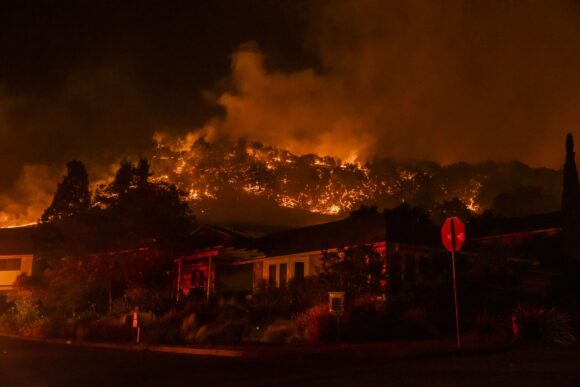A summer that has already seen water crises and wildfire smoke is rapidly becoming an inflection point in the pitched battle between climate change and the price of homeowners’ insurance in the US.
American International Group Inc., which has already pulled back from new California business, is now set to curb home-insurance sales for affluent customers in around 200 ZIP codes across the US, including New York, Delaware, Florida, Colorado, Montana, Idaho and Wyoming. The decision was first reported in the Wall Street Journal on Thursday, citing people familiar with the company’s plans.
AIG’s decision comes on the heels of both State Farm and Allstate Insurance Co. announcing plans in recent weeks to stop writing new policies in fire-prone California. In Florida, meanwhile, the past 13 months have seen seven of 47 local property insurance businesses go under, and another 24 are now on a regulatory watch list.
But the AIG move stands out, both because of the broadness of its reach — touching states that are not normally considered in the high-risk pool — and what that breadth says about the years to come. A warming world means rising waters, stronger storms, more wildfires and more places experiencing extreme weather and natural disasters. Anyone in a high-risk area, whether the woods of New Jersey or the floodplains of Illinois, could see their access to insurance affected.
Insurance experts say the industry’s reaction tracks. Natural-disaster losses from 2020-2022 in the US caused a record $275 billion in insured damages, according to the American Property and Casualty Insurance Association. Those figures, combined with the impact of high inflation on replacement costs, have insurers scrutinizing vulnerabilities beyond traditional regions of risk.
“The risk is unprecedented and the peak risks, which are what cause insurance companies to worry about insolvency, are the ones having the most change with climate,” said Nancy Watkins, a principal at Milliman Inc., an insurance consulting firm. “What we should expect to see is more of these pockets of insurance unavailability, where the market contracts.”
At the core of the problem is a disconnect between the rising perils of climate change, how those perils are assessed by insurance companies and how much customers are willing to pay to protect against them.
Traditionally, insurers have looked backwards to predict risk, and some states even limit the degree to which insurance companies can rely on predictive computer modeling. But as escalating catastrophes take a toll on bottom lines, insurers are getting better at looking forward — and the results aren’t pretty. Insurance rates are rising nationally, although unevenly.
When homeowners can’t afford or access private insurance, state-backed insurers of last resort have to step in. More than 50 years ago, for example, the industry calculated that flood insurance was a bad bet. Now, over 90% of residential flood insurance in the US is underwritten by the National Flood Insurance Program through the Federal Emergency Management Agency. In Florida, state-run Citizens Property Insurance, created in 2002, is today the state’s largest property insurer with 15% of the market, according to Bloomberg Intelligence. California and Louisiana are also experiencing major private-sector pullouts thanks to intensifying storms and wildfires.
Watkins said now a number of other state governments are beefing up the subsidized insurance market to deal with private-insurer retrenchment. Colorado, for example, which experienced destructive wildfires in early 2022, is debating adding a state-backed fire insurance option for those who can’t access the private market. North Carolina has something similar in place for coastal properties.
“Simply put, climate change has now put us in a place where insuring certain properties is not actuarially sound,” said Matthew Eby founder of First Street, a nonprofit that uses data to make climate risks more transparent. “This is a pattern that has only just begun and will dramatically accelerate as the climate continues to warm.”
Photo: Fire burns over a ridge behind houses near the Skyhawk Park neighborhood of East Santa Rosa during the Shady Fire in Sonoma County, California (Bloomberg)
Was this article valuable?
Here are more articles you may enjoy.



 Maui Fire Is Deadliest in US in 105 Years, With 93 Killed
Maui Fire Is Deadliest in US in 105 Years, With 93 Killed  Security First Accountant Charged with Siphoning $1.4M Through Fake Invoices
Security First Accountant Charged with Siphoning $1.4M Through Fake Invoices  Missouri’s Cameron Mutual Placed Into Rehabilitation
Missouri’s Cameron Mutual Placed Into Rehabilitation  Could Georgia Be Next With Major Tort Reform? Kemp Calls for Limits
Could Georgia Be Next With Major Tort Reform? Kemp Calls for Limits 

